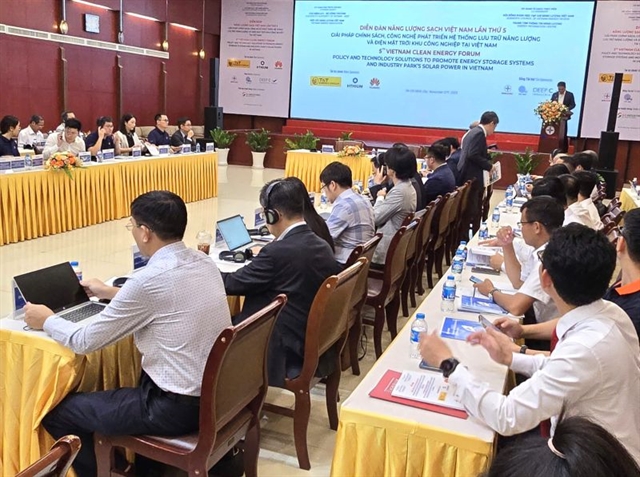 Society
Society

 |
| A view of the Vietnam Clean Energy Forum in HCM City on Friday. — VNA/VNS Photo |
HCM CITY — Việt Nam plans to develop large-scale energy storage systems as part of its strategy to stabilise its fast-growing renewable power grid and meet its net-zero emissions target by 2050, officials said at a forum in HCM City on Friday.
Speaking at the fifth Vietnam Clean Energy Forum, Nguyễn Thế Hữu, deputy director of the Electricity and Renewable Energy Authority under the Ministry of Industry and Trade (MoIT), said storage technology has become a “critical enabler” of Việt Nam’s clean energy transition as renewables increasingly dominate new power capacity.
“Energy storage systems are not only a backup solution but the foundation for a modern, resilient and flexible power grid,” he said.
“They play a vital role in balancing supply and demand, regulating frequency and voltage, and improving grid stability as the share of solar and wind power rises.”
Massive investment challenge
Under the adjusted Power Development Plan VIII (PDP VIII), Việt Nam plans to install 2,400–6,000 MW of pumped-storage hydropower and 10,000–16,300 MW of battery storage capacity by 2030 to support intermittent renewable sources such as solar and wind.
Experts at the forum noted that the investment needed for such projects will be substantial, while electricity pricing and market mechanisms for energy storage remain underdeveloped.
Without a clear policy framework, it will be difficult to attract sufficient private capital for large-scale storage infrastructure, they said.
Việt Nam currently has more than 20 GW of solar and wind capacity, accounting for over a quarter of its total generation mix.
However, grid overloads and weather dependency have led to frequent curtailments, underscoring the urgent need for energy storage to stabilise and optimise renewable output.
Circular economy opportunities
Delegates also discussed global technology trends, battery recycling, and opportunities to localise and build a circular economy around Việt Nam’s emerging energy storage supply chain.
New storage technologies, including lithium-ion, sodium-sulphur, hydrogen, and gravity-based systems, are being studied for potential deployment.
Domestic manufacturers are also exploring ways to produce key components locally.
“Việt Nam has the opportunity to develop its own energy storage ecosystem, not just as a user, but as a producer and exporter of storage solutions for the region,” said a representative of the Vietnam Energy Association (VEA), which co-hosted the forum with MoIT.
The discussions also highlighted the growing role of industrial zones in the transition, where rooftop solar paired with on-site battery systems can reduce reliance on the national grid and lower energy costs for factories.
Policy push for green transition
As part of its Just Energy Transition Partnership (JETP) with G7 nations, Việt Nam has pledged to triple renewable energy generation by 2030 while gradually reducing its reliance on coal.
Policymakers said energy storage will be crucial to achieving this balance.
“Storage is the bridge that connects renewable expansion with grid reliability,” Hữu said. “It allows us to fully capture the value of green energy while ensuring the stability of the national power system.”
Foreign investors from Japan, South Korea, and Europe expressed interest in exploring pilot storage projects under the sandbox mechanisms being drafted by MoIT, which aim to encourage early adoption of battery storage and smart grid solutions.
Experts concluded that Việt Nam’s journey toward carbon neutrality will depend not only on renewable generation but also on its ability to integrate storage, mobilise green finance, and build domestic technological capacity. — VNS




.jpg)